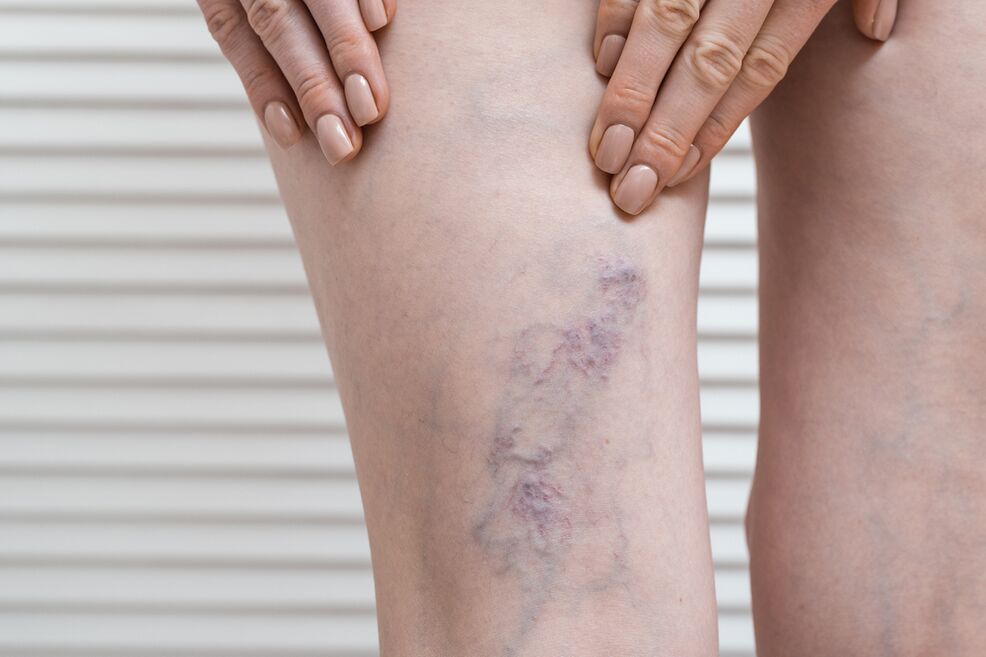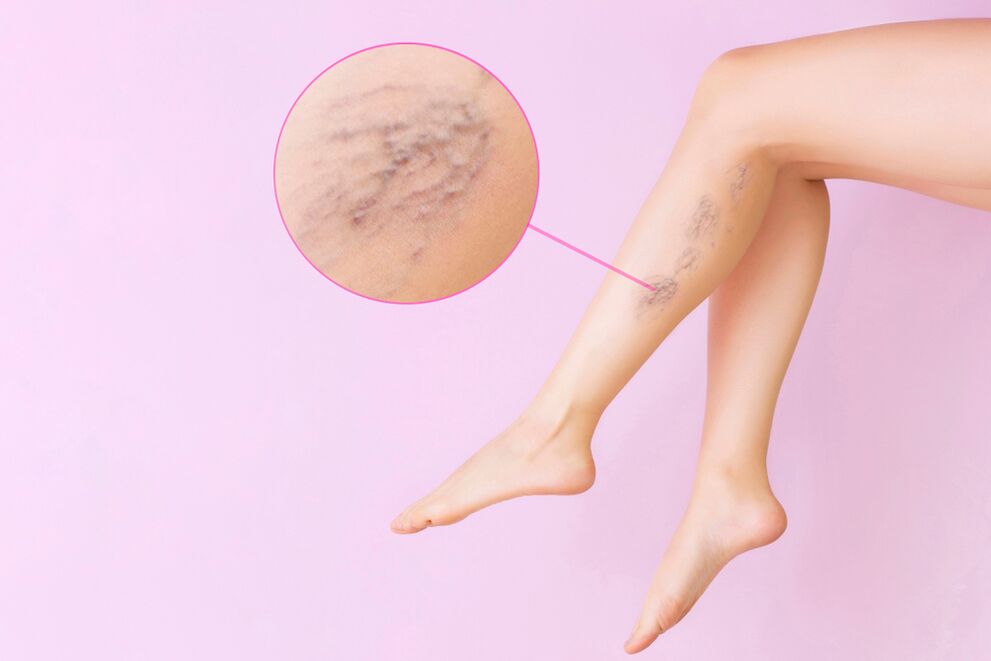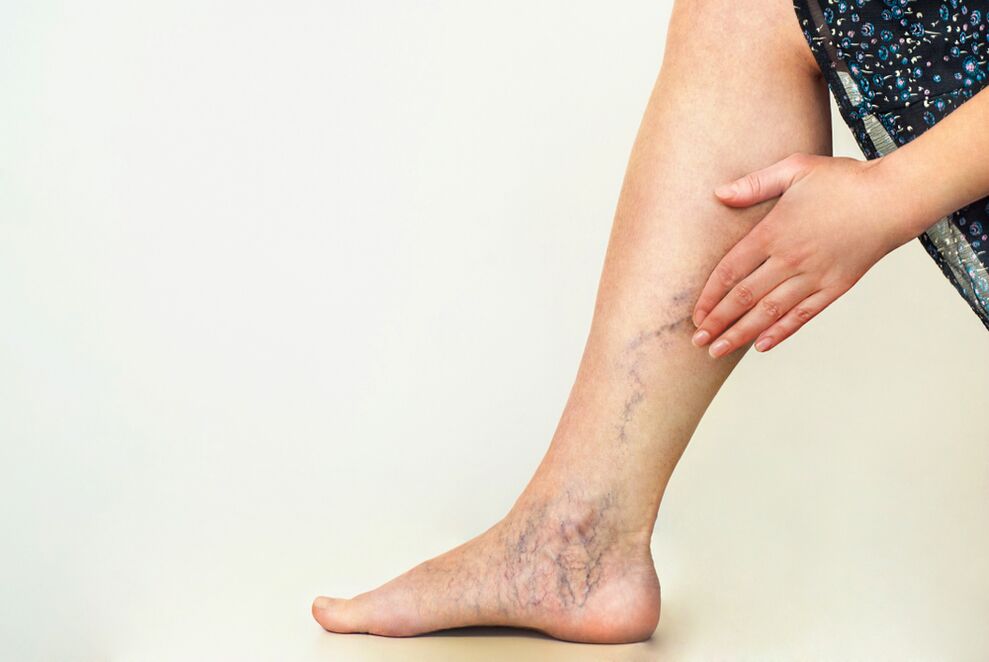Varicose veins in the legs are a pathology of the subcutaneous veins, in which they expand, thin and become inflamed. The venous valves become inefficient, leading to swelling, pain and circulatory problems. A dangerous complication of varicose veins is thrombophlebitis (inflammation of the vascular wall with the formation of a blood clot), trophic ulcer, separation of a blood clot, embolism of the lungs and other organs, hemorrhage.

causes of the disease
- genetic predisposition;
- long work on your feet or sitting, heavy loads, lifting weights;
- hormonal changes during pregnancy, private birth
- overweight;
- advanced age and gender (30% in women, 10% in men)
Symptoms of varicose veins and the mechanism of development
- swelling in the legs in the evening;
- leg pain, heaviness;
- vascular network, blue skin tone;
- increased fatigue from physical exertion;
- Lumps on the veins, pain, inflammation;
- itching on the skin, cramps;
- darkening of the skin;
- Thrombophlebitis, trophic ulcer.
Varicose veins in women often appear during childbirth, but with timely treatment they pass. The situation is worse if a woman does not go to the doctor and expects to improve after childbirth. However, we must remember that varicose veins do not go away on their own.
There are two sectors of the venous bed: peripheral and deep. Normally, the blood should move from the periphery to the center, i. e. upwards. However, when the tone of the valves and blood vessels is reduced, blood begins to move into the superficial veins. This lengthens, stretches, forms knots that are visible even without instruments. If you do not change your lifestyle and start therapy, then the disease will progress, since, according to the law of gravity, the blood tends to sink. Drugs and remedial gymnastics no longer help at this stage.
diagnosis
In most cases, an examination of the legs by a doctor and an ultrasound are sufficient. If there is a risk of recurrence of varicose veins, an examination of the deep veins by X-ray and injection of a contrast agent (phlebography) is required.
How to treat varicose veins in the legs?

In the initial stages of the disease, when there are no visible veins and pain, but there is a feeling of heaviness in the legs, it makes sense to consult a doctor and start prevention. Medicines for internal and external use, an active lifestyle, gymnastics, wearing therapeutic compression stockings (the list of medicines is at the end) are suitable here.
Preventive measures bear fruit, especially if you change jobs and do not stay upright for a long time. Physical activity recommended by a doctor improves circulation because the working muscles of the legs significantly tighten blood vessels. Unfortunately, many people ignore the primary signs of varicose veins. In the future you have to resort to expensive methods.
Modern methods of treating varicose veins
Now there are effective methods of treating varicose veins without surgery. Their meaning boils down to the following - pathological veins are removed from the bloodstream. With the help of a laser or another method, the wall of the damaged vein is glued in the area of the valve and no more blood can get into this section of the canal. For laser access, one or more punctures are made, without anesthesia and without incision, long-term rehabilitation is not required. As a result, proper blood movement is restored, lumps, swelling and pain disappear. The skin color returns to normal, it becomes smooth.
Consider in more detail the methods of therapy without surgery
Treatment of patients with a laser has become widespread over the past decade. If a previously damaged vein had to be surgically removed, which put a person at risk and prolonged hospitalization, then these techniques are outdated in our time. Internal vein coagulation with a laser is widely used. A laser fiber is inserted into the vein through a thin puncture and guided to the damaged valve. Heating with a jet causes coagulation of the vascular tissue, and as a result of inflammation, the vein walls stick together. The method also works in the later stages of varicose veins, when there are trophic ulcers. Efficacy was found in 98% of patients. On the same principle, therapy is carried out with the help of radio wave energy.
If varicose veins have not reached a dangerous stage, the method of sclerotherapy is used. This technique does not involve the use of heat. A substance is injected into the vein, causing an inflammatory response, followed by filling of the lumen of the vessel. Injections with sclerosing agents have their disadvantages - they have a high rate of recurrence. Sclerotherapy will not correct severe blood flow imbalances in large veins. In addition, there may be an allergy to such drugs, there is a risk of necrosis of vascular tissue. Of the advantages, the low cost of the procedure should be noted. Doctors often combine laser therapy with injections.
In addition to laser treatment, miniphlebectomy is used - removal of a damaged vein through a thin puncture. After the operation, the patient goes home the same day as there are no incisions. The skin acquires an aesthetic appearance, normal color, no scars remain.

Treatment of varicose veins with medication
We note once again that it is impossible to completely get rid of pathology only in a conservative way. Thus, the prescription of drugs is symptomatic and prophylactic. Despite this, many patients who take the course note significant improvements: pain in the legs, swelling and fatigue are reduced.
venotonics
This group includes drugs based on diosmin: they increase the tone of the veins and capillaries, due to which their distensibility and venous congestion decrease. Improves blood circulation, microcirculation, reduces leg swelling, pain, heaviness. An additional indication for drugs is the symptomatic treatment of hemorrhoids.
External forms of venotonics are also made.
A lot of positive things can be said about venotonics with diosmin, their effectiveness has been proven by clinical studies and side effects are rare. Before their appearance, Troxevasin was used on the basis of Troxerutin. It has wide indications, there is an anti-inflammatory effect, but more side effects. Drops based on horse chestnut seed extract tighten vein walls and improve the condition of capillaries. Also indicated for varicose veins.
Anticoagulants for external use
This group includes all gels with sodium heparin. The drug accelerates the resorption of blood clots, reduces swelling in the tissues, increases blood flow in the capillaries and has an anti-inflammatory effect. Varicose veins are the main indication. The gel line with heparin is very large and has different concentrations.
Often heparin is part of the complex external forms of varicose veins.
Physiotherapy for varicose veins
electrophoresis
Under the action of electric current on a special carrier, the drug is delivered directly to the changed vessels (venotonics, heparin). The procedure is painless, takes less than an hour, the course is up to 20 sessions. Effective for strengthening veins, reduces the severity of the disease, but does not completely get rid of the knots.
Lymphatic drainage, pressotherapy
To perform this procedure you will need equipment: a suit, a compressor. Air is supplied to the suit with distribution to the legs. Tissues and blood vessels are compressed, creating an imitation of a massage. Improves the outflow of lymph, excess water. The exposure time is determined by the doctor. But an important contraindication are nodes, protruding veins, kidney diseases. Pressotherapy is indicated only in the initial stages of varicose veins.
magnetotherapy
Influencing the veins with a low-frequency magnetic field. The method also reduces swelling, pain and heaviness in the legs. But of course it doesn't repair a damaged valve. In general, we can say that all types of physiotherapy are good only at the initial stages of varicose veins. We list the general contraindications:
- oncological diseases;
- Pregnancy;
- Hypertension;
- bleeding;
- Tuberculosis;
- Epilepsy;
- blood clotting disorders, etc.
In addition to physiotherapy, regular cycling has a positive effect. Moving the muscles of the legs accelerates the return flow of blood, which over time relieves varicose veins. Swimming brings advantages when the strain on the veins is generally reduced and all muscles are active at the same time. After just one session, swelling is noticeably reduced, and there is lightness in the legs.
At almost all stages of varicose veins, the doctor prescribes wearing compression underwear (stockings, tights, stockings). Elastic fabric supports the veins, improves their tone and prevents swelling. Such products are often worn after operations and not only on the legs to protect the veins. For employees who spend a lot of time standing, anti-varicose vein tights are in dire need. Proper use of them prevents the development of the disease.
Conclusion
Early diagnosis of varicose veins helps to avoid the development of the disease. Playing appropriate sports, taking venotonics is good prevention and treatment at the initial stage. In the case of altered veins, however, only minimally invasive therapy methods or laser exposures can be considered. The technique is associated with high costs, but at the same time it is chosen by most patients. The laser copes with even the most neglected cases. It remains only to inquire about the most professional phlebologists in the area. After all, therapy tactics and combinations of methods cannot be read on the Internet; what matters here is a unique personal experience.



















